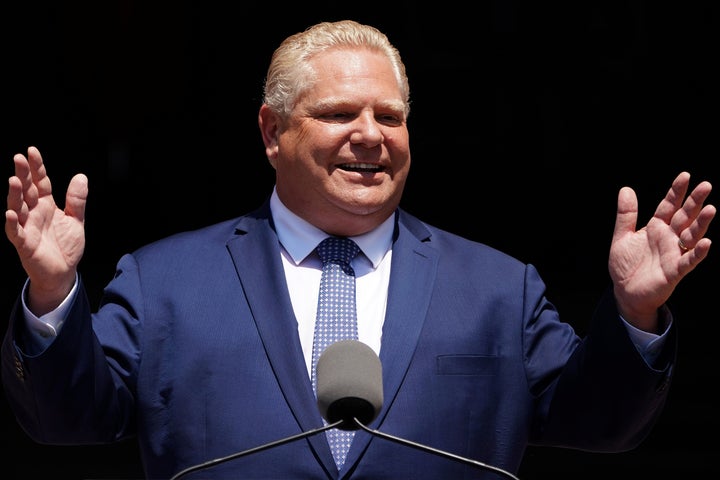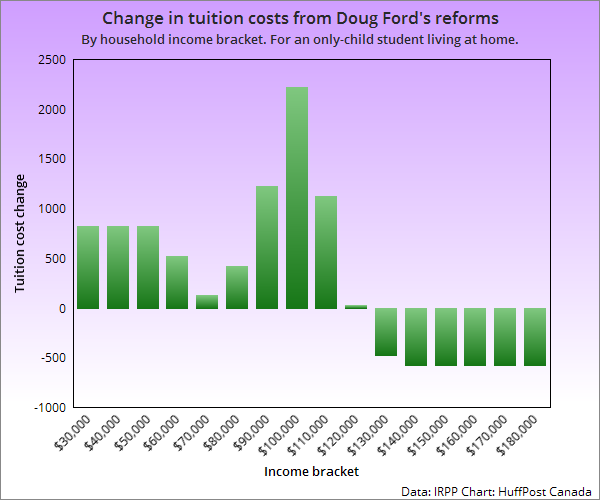
Ontario Premier Doug Ford’s changes to university and college tuition will mean that higher-income people will pay less for post-secondary education overall, while middle-income and lower-income people will see their costs go up, according to a new analysis.
Strangely, the federal government is also a financial winner, the analysis found, as it will mean Ottawa will be reducing its spending on Ontario students by $99 per head, on average.
In a report for the Institute for Research on Public Policy (IRPP), economists from Wilfrid Laurier University estimated that the changes will mean that students from households earning around $130,000 a year or more will see a reduction in schooling costs, while those below that income level will see an increase ― especially those just below that income level.
For a student whose parental or household income is $40,000 a year, and who is an only child living at home, the changes will amount to $800 more in costs per year. For those whose parents or households earn $100,000 a year, net costs will be up by around $2,200 on average.
But the same student will see a $561 decrease in costs if their parents earn $130,000 a year or more.

The provincial Progressive Conservative government has put into place a series of reforms to how students pay for school in the province, announcing a 10-per-cent tuition cut, while at the same time reducing the number of non-repayable grants handed out and increasing the number of repayable loans handed out.
The result is that students who get no aid will save 10 per cent on their tuition, which on average will be $6,600 this year, for a savings of $660. But since tuition is tax deductible at the federal level, those students or their parents will lose out on $99 in tax credits, so they’re really only saving $561. And Ottawa will spend $99 less per Ontario student, or about $60 million less per year.
“The basic story here is that anyone who was previously receiving OSAP (Ontario Student Assistance Program) funding of any sort is going to see that cut,” said Christine Neill, an associate professor in economics at Wilfrid Laurier University, and co-author of the analysis.
Earlier on HuffPost: Ontario students protest against tuition changes. Story continues below.
The province’s rationale for the changes centres around a report from the Auditor General last year which concluded that the previous government’s expansion of OSAP would cause a massive spike in the cost of the program, rising 50 per cent to $2 billion a year by the 2020-21 school year. It also found that the more generous student aid policy led to no increase in attendance.
Neill suspects that $2-billion estimate overstates the reality. She notes that, in the first year of the Liberals’ reforms, Ontario saved nearly $500 million in costs for forgiven loans. Under the Liberals’ system, there were fewer loans to forgive as most of the money was handed out as grants.
“It’s not this completely unsustainable program as has been suggested,” she said in an interview with HuffPost Canada. All the same, OSAP costs jumped by 20 per cent in the first year of the Liberals’ plan, to $1.61 billion, the auditor general’s report showed.
And Neill argues that the lack of increased attendance was also a flawed conclusion, as the idea behind the generous OSAP program was to get high school students to adjust their expectations in the years before they graduate. So measuring the impact on attendance after just one year makes little sense, she argued.
And while provincial officials have stressed that the new program is better targeted at individuals who are actually in need, as it reduces the income threshold at which a student can qualify, Neill argued that this is misleading, because the total amount of money being handed out to students will be reduced.
Neill also expects that student debt burdens will go up as a result. The Auditor General’s report noted that 98 per cent of OSAP money was in the form of grants before the Ford government’s changes, and much of that money will now be in the form of loans.
So will this mean more rich kids and fewer middle-income and low-income kids in post-secondary schools? Neill says it’s hard to say, because no one keeps track of the income distribution of Canadian students.
But she says the “lack of certainty” created around the program by the recent changes will likely discourage low-income students.
“Having some stability in the program and certainty about the availability of funding is important, especially for low income people. The loss of that, I think, could be felt in the years to come.”